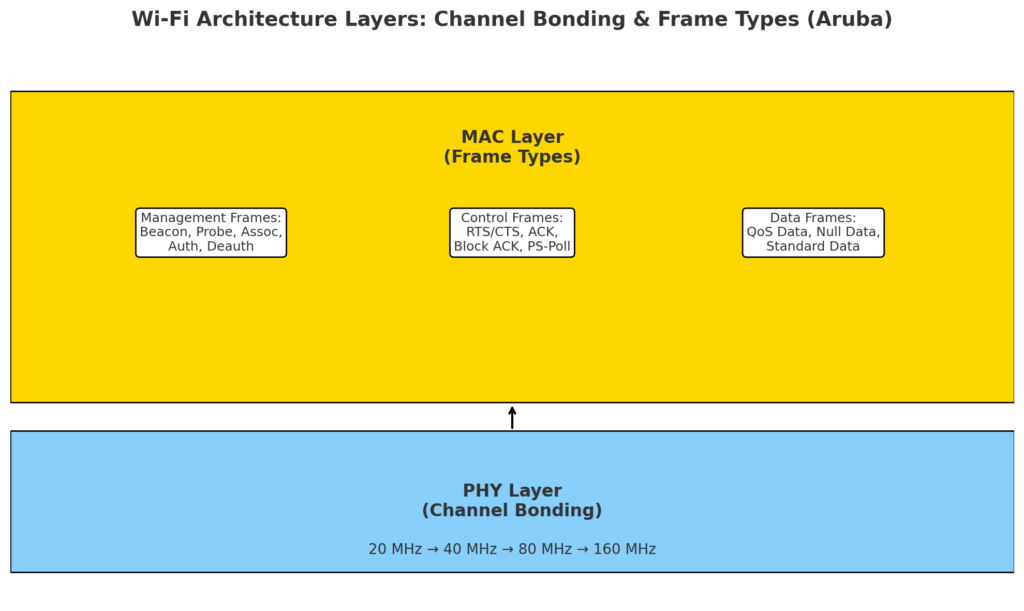1. Channel bonding
What It Is
Channel bonding is the process of combining two or more adjacent 20 MHz Wi-Fi channels into a single, wider channel to increase throughput.
In Wi-Fi:
- 20 MHz → Standard channel width (baseline).
- 40 MHz = 2 bonded 20 MHz channels.
- 80 MHz = 4 bonded 20 MHz channels.
- 160 MHz = 8 bonded 20 MHz channels (in 5/6 GHz bands only).
Why It Matters
- Higher data rates: More bandwidth means more subcarriers in OFDM/OFDMA, allowing more bits per symbol.
- Lower efficiency in noisy environments: Wider channels are more susceptible to interference because they cover more spectrum.
- Fewer non-overlapping channels: This can increase co-channel interference in dense AP deployments.
Aruba-Specific Notes
- Aruba APs support dynamic channel bonding, where the AP can downshift to a narrower channel if interference is detected.
- Controlled by ARM (Adaptive Radio Management) or ClientMatch in ArubaOS.
- 5 GHz channel bonding typically happens in UNII-1, UNII-2, and UNII-2e bands, avoiding DFS issues if required.
- In 6 GHz (Wi-Fi 6E), channel bonding is much easier because there’s plenty of spectrum.
Example in Practice
If your Aruba AP uses 80 MHz on channels 36+40+44+48:
- The primary channel might be 36.
- Secondary channels are 40, 44, and 48.
- If interference hits channel 44, Aruba’s dynamic mechanism might revert to 40 MHz (36+40).
2. Frame Types (802.11 MAC Layer – Aruba)
Wi-Fi traffic is sent in frames (not Ethernet packets directly). The IEEE 802.11 standard defines three main frame types, all supported by Aruba APs.
2.1 Management Frames
Purpose: Establish and maintain communication.
- Beacon – AP periodically broadcasts its SSID, capabilities, supported rates, etc.
- Probe Request/Response – Used by clients to discover APs and by APs to respond.
- Authentication – Initiates connection; can be open or with shared key.
- Association Request/Response – Final step before data transfer.
- Reassociation – Used when roaming between APs.
- Disassociation – Ends the association.
- Deauthentication – Ends authentication.
Aruba twist:
Management frames can be protected using 802.11w (PMF – Protected Management Frames) to prevent spoofing or deauth attacks.
2.2 Control Frames
Purpose: Assist in delivering data reliably.
- RTS (Request to Send) – Used before sending large frames to avoid collisions.
- CTS (Clear to Send) – Response to RTS, granting permission to send.
- ACK (Acknowledgment) – Confirms a frame was received.
- Block ACK – Acknowledges multiple frames at once (improves efficiency).
- PS-Poll – Power Save Poll, lets AP know a client is ready to receive buffered frames.
2.3 Data Frames
Purpose: Carry the actual payload (user data or management info).
- Standard Data – Encapsulates Ethernet payload in 802.11 frame.
- QoS Data – Prioritized traffic (voice, video, etc.) using WMM/Wi-Fi Multimedia.
- Null Data – Data frame with no payload; used for power save signaling.
Aruba twist:
- Aruba APs can tag frames with 802.1p QoS priority before bridging to the wired network.
- In tunneled mode (controller-based), frames go through GRE/IPsec encapsulation between AP and controller.
3. Channel Bonding + Frame Types Connection
- Channel bonding affects the PHY layer, increasing throughput potential for all frame types.
- Frame types operate in the MAC layer, defining how data and control information are exchanged within that PHY capacity.
- Aruba’s ARM + ClientMatch ensures that bonded channels are used efficiently and that clients are connected to the optimal AP/channel width.

- Bottom (blue) = PHY Layer – Channel Bonding
Shows how Wi-Fi combines adjacent 20 MHz channels into 40, 80, or 160 MHz to increase throughput. - Top (yellow) = MAC Layer – Frame Types
Lists Aruba-supported 802.11 frame categories:- Management Frames – Beacon, Probe, Authentication, Association, etc.
- Control Frames – RTS/CTS, ACK, Block ACK, PS-Poll.
- Data Frames – Standard Data, QoS Data, Null Data.
The arrow between them represents the fact that frame types are delivered over the PHY layer capacity created by channel bonding. This shows how the physical bandwidth and the logical frame handling work together in Aruba Wi-Fi.